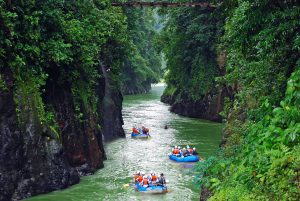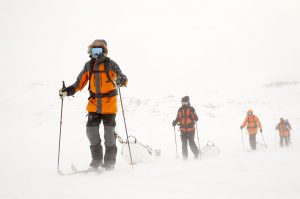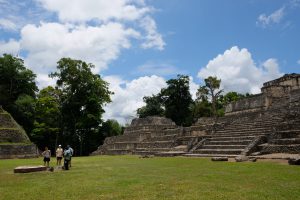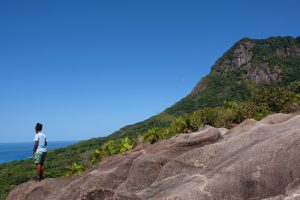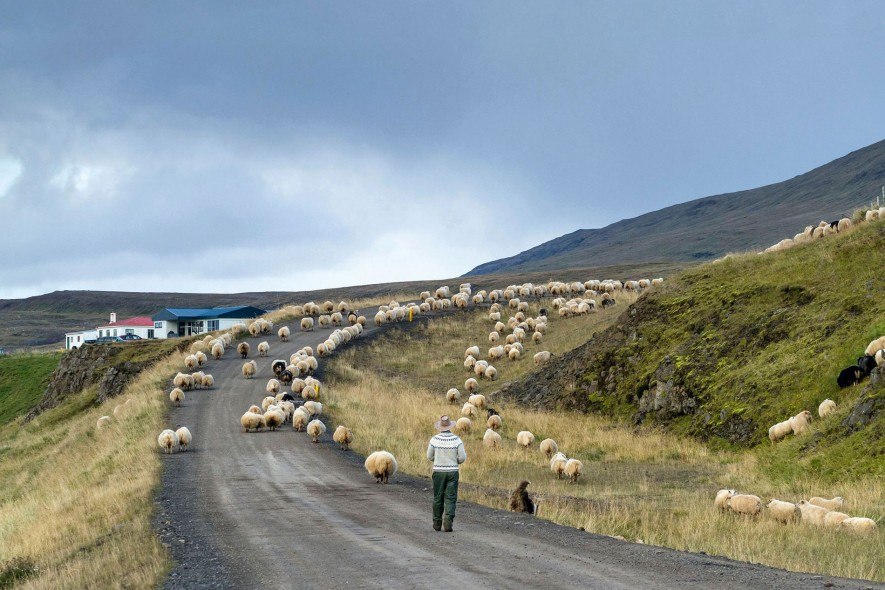
Trace the very edge of the world on a new road trip around Iceland’s northernmost reaches. Here, long summer days spent exploring element-blasted peninsulas and fjords rich in marine life are teamed with stays in cosy fishing towns swirling with stories — after all, this is the land of sagas
View online at nationalgeographic.com
The proprietress of the Museum of Prophecies rests her knitting needles on her lap as I enter, and regards me quizzically from her armchair. Clearly, it’s not every day she gets visitors. The exhibition space is low-lit and cosy; near the entrance, tables are laid out for tarot readings, divination by tea leaves, the tossing of runes, and palmistry. Towards the back of the room, friezes depicting old Icelandic sagas snake across the walls. A stuffed raven peers at me from atop a display case, and an empty treasure chest rests at the feet of a queenly, robed mannequin. “Would you like me to tell you our story?” Dagný Marín Sigmarsdóttir asks, in sing-song English. I wonder if she’s already predicted my answer.
Iceland is awash with stories. History, legend and folklore cover this land as thickly as the winter snows. They have a particular resonance along its Arctic frontier, in the remote fishing communities dotted around the jutting northern peninsulas. In centuries past, locals would hold evening vigils to recite rímur — poetic reworkings of the sagas documenting early Icelandic history, filled with bloodshed and heroism. Here at this museum in the hamlet of Skagaströnd — a cluster of houses and farms stitched into the base of Spákonufell mountain — this tradition, and the ancient texts, have been updated for the 21st century.
“The museum is dedicated to one of the first settlers in this area, a powerful 10th-century fortune teller called Þórdís,” explains Dagný. “She appears in four sagas as a side character, normally administering potions to warriors; it’s not until now that she has her own story. The sagas, after all, were written by men.”
Local folklore, passed down through the generations, fleshes out the life of the local sorceress. According to one tale, Þórdís, having foreseen her death, took her gold to the top of Spákonufell and hid the treasure with an enchantment. “It’s said that only a woman can find the chest. When she does, two ravens will appear to her, holding the key in their beaks. I’ve climbed Spákonufell a hundred times to look,” Dagný says sadly. “If you find it, let’s say we split it 50-50.”
The colours of the landscape have deepened by the time I start up my car and continue along the coast. The sun is gingerly lowering itself towards the ocean, ushering in one of the lingering golden dusks that typify Icelandic late summer. The mountain, which did not offer up its treasure on my hike, shrinks to a molehill in my rear view mirror. Lustrous clouds unfurl across the land and sea like the coming of divine revelation. Ravens burst from the heather as I pass, and curly horned rams, gifted bright coronas by the dying light, turn to observe me warily. I drive for hours and don’t see another village or vehicle. It’s not a landscape one would necessarily associate with Iceland (there are no exploding geysers or huffing volcanoes in these parts). But out here I can park up and watch gulls spiral above otherworldly basalt sea cliffs; stroke stocky ponies grazing road-side; and eat a packed lunch on a pebble beach among basking seals, all in utter solitude.
This is the charm of exploring Iceland’s Arctic Coast Way. Launched by Visit North Iceland in summer 2019, it invites travellers to experience the country’s rugged north via an epic road trip. My self-drive adventure — complete with wheels and cosy B&Bs — is choreographed by Discover the World, the first tour operator to base an itinerary around the route.
The Arctic Coast Way starts in the village of Hvammstangi and follows the filigreed coastline of seven peninsulas — each with their own geological marvels, stories and wildlife — ending 560 miles later at Bakkafjörður in the east. Signposts mark the way: a white infinity symbol over a sketched outline of Icelandic territory.
This is truly the road less taken; tourism has yet to get much of a foothold in these parts, and a four-wheel-drive vehicle is obligatory for tackling the gravel tracks. I may only be a half-day’s drive from Reykjavík but these lonely shores feel a million miles from the capital, and the south’s popular geological hotspots. “The north won’t change; it’ll never be Reykjavík,” Dagný had told me confidently as she’d laid out tarot cards to probe my future. “We’d love more travellers to come this way; to share the beauty we have here.”
I hear a similar message in Sauðárkrókur. Having driven around the first two peninsulas — Vatnsnes and Skagi — I’m hanging my hat in this picturesque port town at the crook of the dramatic Skaga Fjord. Compared to the settlements I’ve seen thus far, it’s positively cosmopolitan: there’s a pub open late, and a restaurant with a menu of northern delicacies. (A word of warning: cured foal and smoked sheep are definitely acquired tastes.) I check into Hótel Tindastóll, Iceland’s oldest hotel — a melange of narrow staircases, crooked ceiling beams, and fire-side seats with fur throws. Framed photos of one-time guest Marlene Dietrich add a touch of glamour to my cosy garret room.
In the morning, Áskell Heiðar Ásgeirson meets me down at the waterfront. “Travellers pass by Sauðárkrókur on the ring road, or they stop quickly for lunch. We’d love them to linger here — to spend a night at least, like you. That’s why we’ve created this.”
Áskell’s creation is 1238: The Battle of Iceland, an interactive exhibit that uses jazzy virtual- and augmented-reality technology to place you front-and-centre in the bloody battles and intrigue of the Sturlung Era. “There were so many killings and betrayals within the family clans; it’s a real-life Game of Thrones.” The eponymous 13th-century battle is perhaps the most famous in Icelandic history. It happened not far from where we’re standing, and the carnage resulted in the island ceding its independence to the Norwegian crown. Iceland wouldn’t become sovereign again until 1944.
Áskell equips me with VR goggles, gloves and a vest and plugs me into the past to see how I fare. Fighting alongside my clan leader, Sturla Sighvatsson, I’m supposed to pick off our attackers by hurling rocks and spears. Sadly, my aim has never been good, and I fail to dodge incoming projectiles. My vest vibrates violently as the enemy land blow after blow. I live long enough to see Sturla fall from his horse. His legendary spear, Grásíða, rolls through the grass to my feet; I gather it up and flee. I feel a little nauseous, but whether that’s the effect of the VR or the fight, I’m unsure. “We may not have the biggest waterfalls here or the most dramatic glaciers, but we have our stories,” Áskell says proudly after I emerge from the game. “That’s our great treasure.”
A ghost town reborn
The elemental beauty of the next peninsula, Tröllaskagi, proves a driving hazard. Twists of the road reveal vistas so vast and breathtaking they’re distracting. The Arctic Coast Way takes me through Arcadian valleys of patchwork pastures and wind-raked lakes of brushed metal, up into blustery highlands with views across the ocean. Here, the mossy rocks appear so purposely placed, so square and stacked, they could be the ruins of a citadel. I wind down the windows and try to focus on the narrow road as it rises steeply towards the sky. At times, the clouds seem only just out of reach.
At the very tip of the land, accessed by a series of narrow mountain tunnels, stands the fishing port of Siglufjörður. Sigló, as it’s affectionately known in Iceland, is an up-and-coming weekend getaway. Summer homes with old-fashioned pitched roofs creep up the foothills and overlook the fjord, and the working dock is flanked by two smart restaurants and a boutique four-star hotel. Elsewhere, a former fish factory has been converted into a craft brewery, Segull 67, and murals add pops of colour to side streets. It’s all so pretty, it belongs on a postcard. But only a few decades ago, before the recent flurry of investment, arriving in Sigló would have felt like stumbling into a ghost town.
“After 1969, no one returned. The town just rotted,” my tour guide, Edda, explains. We’re wandering around the award-winning Herring Era Museum, which, despite its name, isn’t really about the fish at all. “We renovated these waterfront houses and collected these artefacts to capture the human stories of an incredible period in our history. We call it the Herring Adventure.”
Herring fishing in Sigló began in the early 1900s. The fjord was home to just a handful of rustic turf houses at the time, but a port was soon founded and a town sprung up to serve the lucrative new industry. At its peak, Sigló was home to 12,000 seasonal workers during the summers. “There was a high street with a cinema and candy factory, and fashionable dances. People said it had the atmosphere of a big European city; men and women people came from all over Iceland to make their fortune. And then, as quickly as it started, it all ended. They’d overfished the herring.”
Sigló’s tale of boom and bust, Edda suggests, serves as a parable for mankind’s hubris and the need to foster sustainable relationships with the natural world. By the end of the 1960s, there was nothing left to catch. This led to the Cod Wars of the 1970s, in which Icelandic fishermen clashed with British trawlers as they looked further afield to fill their nets. The lesson, to some extent, has been learned: Iceland is now more mindful of its natural bounty — it’s currently the only country in the world that generates all its energy from renewable sources. In August 2019, the prime minister, Katrin Jakobsdottir, held a ‘funeral’ for a glacier in protest at global warming. Mindful of the impact of the recent tourism boom (arrivals increased fivefold to 2.2 million between 2010 and 2017), all incoming travellers are now asked to subscribe to a pledge to respect and preserve the landscape. As I listen to Edda speak, upholding this promise strikes me as the very least I can do.
The following day offers further insights into Iceland’s marine ecosystems. I’m aboard a traditional wooden schooner, heading north across choppy waters. As I cling to the railings and try to keep my breakfast down, a cheery voice comes across the tannoy: “The name of this stretch is Skjálfandi, meaning ‘shaky bay’. Most people think it’s because of the swell of the water, but it’s actually because the area is prone to earthquakes.” The cosy town of Húsavík, with its chocolate-box church, clifftop geothermal pools, and riding stables, is fading to a whitish smudge behind us. The bay is flanked by mountains. Up ahead — just 30 miles north, beyond the gaping mouth of Shaky Bay — lies the Arctic Circle.
Húsavík is ‘the whale-watching capital of Europe’, so I’m on the lookout for the telltale signs: a splash, a spurt or a tail; a flock of gulls circling above the waves. Eleven species visit the area to feed, including the planet’s largest animal: the blue whale. “We saw one on a tour last week,” marine biologist Christian Schmidt tells me. It’s his tenth summer working for North Sailing, the oldest of the four whale-watching outfits in Húsavík, and he has a brilliant eye. “Harbour porpoises on the boat’s left,” he shouts. We watch a small pod playfully crest and skim through the waves, before continuing our search for a bigger prize. It comes soon: a solitary humpback whale. We follow it from a respectful distance, cooing each time it emerges from the inky depths, then listening rapturously to its rasping exhalations.
On the long journey back to shore, I ask Christian about the status of whaling in Iceland. The country is one of just three in the world that grants licences to hunt cetaceans — a surprising blight on an otherwise largely progressive political agenda. “In Húsavík, at least, there’s no question about it: whales aren’t on the menu,” Christian responds firmly. “Nor puffins. My feeling is that it’s only offered for tourists; no one in Iceland wants this anymore. Maybe if tourists refused to try it, we can make a change,” he suggests. I mentally add a new tenet to my Icelandic Pledge.
Journey to the end of the Earth
As my week in the north draws to a close, I take an inland detour, temporarily leaving the quiet majesty of the Arctic Coast Way to tick off one of the region’s show-stopping attractions: Mývatn. The tranquillity of this lake and surrounding, bird-filled wetland belies the seething, subterranean forces at work here. It rests on top of the Mid-Atlantic Ridge — the meeting point of the North American and Eurasian tectonic plates. I circle the lake, passing nesting grounds and scattered islands, to reach its eastern shore. Here, I’m met by an embarrassment of geological curiosities — and, for the first time on my trip, coach-loads of other travellers. Hverfjall, a towering crater, dominates a landscape of belching mudpots, sulphurous fumaroles, sunken pseudocraters and sculptural lava fields. I spend the day hiking through this wonderland in a state of near-constant awe; I feel I’ve been gifted an insight into the violent forces lurking at the planet’s core.
Luckily, I find a place to allow the geology lessons of the day to properly sink in. Mývatn Nature Baths are the North’s answer to Rejkjavík’s perennially busy Blue Lagoon. Soaking in a ‘hot pot’ is a national pastime. Recommended accessories include a crisp, freshly pulled pint of lager from the bar and a woolly hat. I jog from the changing rooms, through the frigid evening air and wade out into the milky water. It’s gloriously hot, and while there are several dozen other bathers, I have plenty of room to myself. The only thing to do is to find a ledge — silky with built-up mineral deposits — and watch the wind whip at the rising steam, causing the sweeping landscape to shift in and out of sight.
Despite the drama of the Mývatn region, I’m eager to return to the coast — to the unsealed roads, the weather-beaten lighthouses and the iridescence of the ocean. It’s a spectacular half-day drive to rejoin the Arctic Coast Way. Standing between me and the sparsely populated peninsulas of the north east are two welcome pit stops: Europe’s most powerful waterfall, Dettifoss, where rainbows arc through the almighty spray, and the canyon of Ásbyrgi, with its forested hiking trails and emerald lake. According to early myths, the horseshoe-shaped gully was created by the hoof of Oðin’s huge, eight-legged steed. Ásbyrgi later became thought of as the capital of the Huldufólk — the hidden people, or elves. “Those who’ve seen them say they look much like you or me, but taller and more beautiful, and wearing fine gowns,” the young ranger at the trailhead tells me earnestly.
Back on the coastal road, I round the tip of the Melrakkaslétta Peninsula. I’m less than a mile south of the Arctic Circle. The ocean, my constant companion on this road trip, segues serenely through shades of deep blue and grey to the lip of the horizon. Inland, on my right, are creeks and heathlands rendered ghostly-white by frost-hued scrub and profusions of cottongrass. It feels like the very edge of the world.
A handful of people call Melrakkaslétta home — most concentrated in or around the village of Raufarhöfn. It’s a place few travellers venture to. But that hasn’t stopped the locals dreaming up an ambitious hilltop attraction. I trudge up to see it, the wind battling me at every step. Overlooking the sea is a monumental sundial built in the image of Stonehenge. It’s only half-finished, but already its five rough-hewn portals frame the landscape and evoke the country’s pagan roots. When completed, it’s hoped the Arctic Henge will be a site of pilgrimage for aurora chasers, and host festivals on the solstices. Its final architecture, I read in my guidebook, will also speak to Norse mythology surrounding the cosmos’s birth and death as set out in the medieval poem Völuspá. The north, it seems, is forever finding new and interesting ways to tell its ancient tales. This is a story I’d love to hear, but for now at least, there’s nothing here but the stones, the ocean and the sky.
ESSENTIALS
Getting there and around
Icelandair, EasyJet and British Airways fly direct to Reykjavík’s Keflavík International Airport from, variously, Heathrow, Gatwick, Bristol, Manchester, Belfast and Edinburgh.
Average flight time: 3h15m.
A four-wheel-drive vehicle is essential to safely navigate the steep gravel sections and changeable weather of the Arctic Coast Way. To avoid backtracking across the country, the vehicle can be dropped off at Egilsstaðir Airport, where flights to Reykavík are available. Domestic flights with Air Iceland Connect start from £80.
When to go
The Arctic Coast Way is open in its entirety in summer (May-September, when temperatures average 12C). Many of the route’s attractions and smaller roads are closed during the winter.
Places mentioned:
Hótel Tindastóll
1238: The Battle of Iceland
Segull 67 brewery
Herring Era Museum
North Sailing
Mývatn Nature Baths
More information:
arcticcoastway.is
northiceland.is
Lonely Planet Iceland (2019). RRP: £15.99.
How to do it:
Discover the World offers the 11-night Arctic Coast Way self-drive from May to September. It includes hotel accommodation on a B&B basis, car rental and use of the iDiscover app. From £1,604 per person based on two sharing.
Published in the Jan/Feb 2020 issue of National Geographic Traveller (UK)





